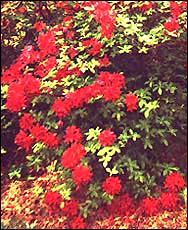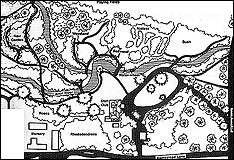Dorothy – 30/10/98
An interview with Peter Cadigan, Superintendent of Grounds, University of Canterbury.

|
| Peter Cadigan in the azalea garden |
I have walked in the gardens at Ilam homestead since I was child and always enjoyed their beauty, but the gardens had a new meaning for me after I walked through them with Peter Cadigan while he talked about the azaleas and rhododendrons and about the development of the site by the University of Canterbury.
Peter Cadigan, Superintendent of Grounds, University of Canterbury Peter has given his life to gardening. He began with his childhood garden carved out of bush in the Buller Gorge on the West Coast of New Zealand. An after-school job in a Christchurch plant shop sparked an interest in the propagation of plants and led to an apprenticeship at the Christchurch Botanic Gardens and the National Diploma of Horticulture. After a period as Assistant Parks Superintendent for the Hamilton City Council he applied for a position as horticulturist working for the Commonwealth War Graves Commission. To his astonishment he was appointed and worked in Italy, Egypt, France and London.
Then he returned to Christchurch to a new appointment as superintendent of grounds at the University of Canterbury in 1974. This was a challenging job as the new campus at Ilam was just being built. I plan to write about that side of the work in a future issue of NZine, but in this article the emphasis must be on the development of the gardens at the Ilam homestead as the gardens are at present at their very best – a riot of colour with azaleas and rhododendrons in full flower.
Ilam gardens and homestead The first person to settle at Ilam was J. C. Watts-Russell, a pioneer who came to Canterbury in 1850, sailing on the George Seymour, one of the first four ships to bring organised settlement to the area. He received a grant of 500 acres and named the property Ilam after his Staffordshire home. He imported a beautiful wooden house, erected it on brick foundations at Ilam in 1858 and developed a beautiful garden around it. Lady Barker, who has left a fascinating collection of writings about early life in Canterbury, went there in 1866 and described the garden. “The Avon winds through the grounds which are laid out in the English fashion – though with a certain absence of the stiffness and trimness of English pleasure grounds. There are thick clumps of plantations which have grown luxuriously.” Watts-Russell’s name appeared frequently in reports of horticultural shows.
Ilam purchased by Edgar Stead

|
| Homestead built by Edgar Stead at Ilam |
Ilam had several owners after the death of Watts-Russell in 1875. Unfortunately the house was burnt down in 1910. In 1914 Ilam was bought by Edgar Stead who rebuilt the house. It was said to have a similar appearance to the original homestead, except that it was built in brick. The house is now used as the Staff Club for the University of Canterbury, and is not open to the public.
Ornithology Stead’s first interest Edgar Stead first began bird watching at his parents’ home, Strowan, now the site of St Andrew’s College, and wrote “Life Histories of New Zealand Birds”. He trained as an electrical engineer and worked for a time in America. When he returned to New Zealand and bought the property at Ilam he developed extensive aviaries and there he treated native birds which were injured.
Azaleas and rhododendrons at Ilam In 1860 Sir John Cracroft Wilson came to Christchurch from India and brought seeds of a few varieties of rhododendrons and raised seedlings. Rhododendrons growing along the drive at Strowan kindled Stead’s interest in these flowers, but there were few varieties available in New Zealand. He imported some for Ilam each year and from 1918 used cool storage for importing them.
The soil at Ilam is a heavy clay which is slightly acid, and is known as Ilam pug. It is particularly suited to rhododendrons, azaleas, and other trees.
Stead began trying out layering, grafting and raising seedlings to produce larger and more brilliant flowers. He was a pioneer in using pinus radiata sawdust as a mulch for the plants.
In 1917 Stead was given seeds of the North American varieties and began experimenting with hybridising them.
In 1925 he went to England to further his knowledge of rhododendrons and azaleas and was invited to the homes of some great hybridists – Lionel de Rothschild, Lord Snow, and Gerald Loder. He was invited to judge at the Chelsea Flower Show. He was given 520 plants by de Rothschild and Loder and 490 of them were planted at Ilam. He returned to England in 1930 and again visited Lionel de Rothschild who had developed the famous Exbury hybrid azaleas. Stead was allowed to make some crosses of his best named varieties. After this the seeds were sent to him and he produced the beautiful azaleas for which Ilam is famous.
Ilam purchased by the University of Canterbury When Edgar Stead died in 1949 the property was purchased by the Government as the new site for the University of Canterbury. One of the conditions of the sale was that the garden be maintained as a whole. For a time the homestead was occupied by the Rector and his family. The gardens were not developed further until the University began its move from the city site and Peter Cadigan and his team of groundstaff began work in 1974.
Types of azaleas

|
| Dark red azalea |
Peter explained that all azaleas belong to the rhododendron family botanically. They come in two types, deciduous and evergreen. The deciduous azaleas are larger than the evergreen. They come in a variety of colours. For some deciduous azaleas two colours have been crossed resulting in two colours in the flowers. The dark red deciduous azaleas are rare.
The evergreen azaleas are small and at Ilam are used as an edging for the beds of larger deciduous azaleas. The predominant colours for the flowers of the evergreens at Ilam are purple and pink, but there are also a number of flame coloured evergreens.
The gardens have not been planned according to a systematic colour design. The rich variety blends into a riot of colour. (See photo spread at end of article)
The Galaxy range of azaleas A special project of the staff at Ilam is the development of new hybrid azaleas – the Galaxy range – which will eventually be offered for sale. The process consists of reselecting the original azalea seeds, sowing them, letting them flower, picking the best and taking cuttings. The twelve best are part of the Galaxy range which have been registered with the Royal Horticultural Society. (See photo spread at end of article) Three have been successfully propagated by tissue culture, otherwise known as micro-propagation. For these three Ilam has obtained plant variety rights – Ilam Galaxy Virgo – a white azalea, Ilam volcano – the orange red of lava, and Ilam Sunlight – a golden colour.
 |
| Map – Ilam Gardens Courtesy of University of Canterbury (Click here for a larger version) |
Exploring the garden If you walk from the homestead across the bridge beside the fountain and the waterwheel, at the top of the path to the right of the redwood is the trial ground for plants from which the seed is collected.
The seedlings are from the azaleas which Edgar Stead imported from Exbury near Southampton. The site offers semi-shade and ample water is provided.

|
| Trial ground for new azalea plants |
In the shade of the gingko tree to the left you can see part of the early planting of rhododendrons. They have been carefully pruned and retained for their historical interest and the colour they provide. Walk further and you will reach the woodland area where daffodils bloom in August and September and bluebells flower in October.
If you walk further west along the Ilam Stream beyond the woodland you reach a small bridge. Cross it and you come into an area of new seedlings. Cherry trees in full bloom blend beautifully with the lower growing rhododendrons and provide them with shade. Along the western boundary alders have been planted to give shade and shelter from the nor’west wind.
Notice in particular the creamy lemon rhododendron, Ilam Canary. (See photo spread at end of article)Rhododendron Loderi Venus with its faint blush is some eighty years old. Peter has found that it is a good indicator of the type of season to come. If it flowers well that is a promise of a good flowering season.
Near the seat built around the cherry tree is the pink IMS rhododendron, named after Irene Mary Stead, Edgar Stead’s wife. (See photo spread at end of article) This is one of the Loderi group which can be recognised by the purple stalks.
Walking back towards the house along the Ilam stream you can see deep in the shade the red blooms of Rhododendron Kingianum with its gnarled trunk and branches indicating its age. It is thought to have been planted there before Edgar Stead took over the garden. This type of rhododendron can be cut well back and will rejuvenate.
Back from the track you will see Ilam Venus Loderi – cream flowers with a blush on the bud.
Walking along the track to the south you will come to another large area where young rhododendrons and azaleas are planted out and a rose garden. On your right is the large shade house where the new azaleas are raised, for the Ilam Gardens, for the gardens surrounding the buildings on the campus, and also for sale. For inquiries about purchasing the plants ring (03) 348 6548.
Developing the new azaleas Developing azaleas by the traditional tip cutting method is a slow process. >From seed to flowering takes five years. A new technique of micro propagation by tissue culture has been trialled. Microscopic pieces are taken off a growing tip and grown in a special nourishing solution in a growth cabinet. This has been done in a commercial biotechnology laboratory in Auckland. Back at Ilam they have to be weaned off the growth solution in a sterile environment to get used to soil, form their own roots and harden up.
The waterwheel and the fountain Originally the water wheel worked on a site in the Heathcote Valley. It was taken to Ilam to pump water for domestic supply from an artesian bore near the water wheel to a water tank on a tower beside the homestead. In the late fifties when high pressure water was reticulated throughout Waimairi County use of the water wheel ceased and it fell into disrepair.
In the mid eighties Peter Cadigan suggested that the water wheel be renovated. It was done in the mechanical engineering workshops and the civil engineering workshops under the supervision of Tom Dodd.
Tom suggested that a fountain be installed behind the weir and this was done in 1988 at the same time as the waterwheel was renovated. (See photo spread at end of article)
Waterways at Ilam Two streams join in the Ilam Gardens – the Avon River and the Ilam Stream. The flow in the Ilam Stream has tended to become very sluggish in dry seasons. The University of Canterbury obtained a consent under the Resource Management Act to pump some water from the Avon River to Ilam Stream in the vicinity of Waimairi Rd to improve the flow in Ilam Stream.
These two waterways enhance the beauty of the property at any time but especially when the rhododendrons and azaleas are flowering on their banks and reflected in the water.
Visiting Ilam The gardens are open to the public from 10 a.m. The main entrance is in Ilam Road. Buses from Cathedral Square stop at the gate. At the time of writing the bus stop is on route 21.




